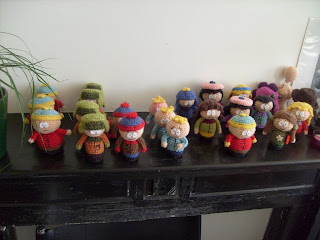
At threadonism.com you can find examples of HYPERBOLIC CROTCHET OBJECTS, each a unique model of mathematically defined HYPERBOLIC STRUCTURES. Bridging the gap between art and science, crochet is an ancient craft, both practical and functional in communities around the world and relatively ubiquitous in it's application, croctet manifests structures, in this case HYPERBOLIC STRUCTURES, from simple threads (STRINGS) by way of a knotting or folding pattern, each twist is a rather complex operation, on the one hand, and a simple to pick up - handycraft - on the other.
Hyperbolic Crotchet seems to be a great tool for bringing craftspeople and academic scientists together in a new and creative way, bridging the gaps between specialization and comprehensive knowledge systems and most importantly engaging human beings in ancient craft activities - physically and mentally - providing an alternatve reality engineering activity outside of the growing virtual - mental - social electronic frontere.
Youtube and internet were the winds that blew the seeds of hyperbolic crotchet into my own life, and my partner has become a Hyperbolic Crotchet master in a matter of just a few months. I am excited to see such an idea manifest as a reality in front of my eyes - a mathematical proof and more - in fact, and beautiful like the fractal artwork explosions, soft, colorful, and malluable. I will share some of the relative links and extensions of the Hyperbolic field, that I feel help describe the importance of this growing craft, and also to pay tribute to the beautiful objects created by Janne at THREADONISM.COM
FROM WIKIPEDIA:
Hyperbolas share many of the ellipse's analytical properties such as eccentricity, focus, and directrix. Typically the correspondence can be made with nothing more than a change of sign in some term. Many other mathematical objects have their origin in the hyperbola, such as hyperbolic paraboloids (saddle surfaces), hyperboloids ("wastebaskets"), hyperbolic geometry (Lobachevsky's celebrated non-Euclidean geometry), hyperbolic functions (sinh, cosh, tanh, etc.), and gyrovector spaces (a non-Euclidean geometry used in both relativity and quantum mechanics). http://en.wikipedia.org/wiki/Hyperbola
Bernhard Riemann, in a famous lecture in 1854, founded the field of Riemannian geometry, discussing in particular the ideas now called manifolds, Riemannian metric, and curvature. He constructed an infinite family of non-Euclidean geometries by giving a formula for a family of Riemannian metrics on the unit ball in Euclidean space. Sometimes he is unjustly credited with only discovering elliptic geometry; but in fact, this construction shows that his work was far-reaching, with his theorems holding for all geometries. http://en.wikipedia.org/wiki/Non-Euclidean_geometry

No comments:
Post a Comment